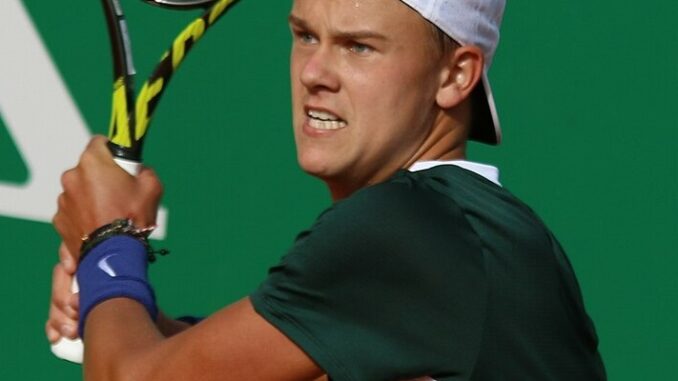
At the Paris Masters 1000 2022, a player from Denmark won his first ATP 1000 title, six months before his 20th birthday. And what is even more impressive is that he won against one of the greatest players of all times, Novak Djokovic, in straight sets.
As tennis fans know very well, the name of this young player, now in 7th position of the ATP ranking, recently again in a Master 1000 final in Monte-Carlo (losing to Rublev), is Holger Rune.
Rune turned professional in 2020 and won nine ITF Futures titles and two ATP Challenger titles in 2021. He made his breakthrough in 2022, when he won his first ATP title in Munich and then, as previously mentioned, stunned the tennis world by winning the Paris Masters, beating five top-10 players along the way, including Djokovic.
Some data about him (as on May 2023):
- He has a career win-loss record of 71-46 (60.68%) in singles
- He has earned more than four million dollars in prize money so far
- He has a winning percentage of 63.64% on clay courts, 57.14% on hard courts, he has not won a single ATP match in singles on grass yet.
In the following, we will focus on this last element, analyzing his game separately by surface.
Rune on Clay
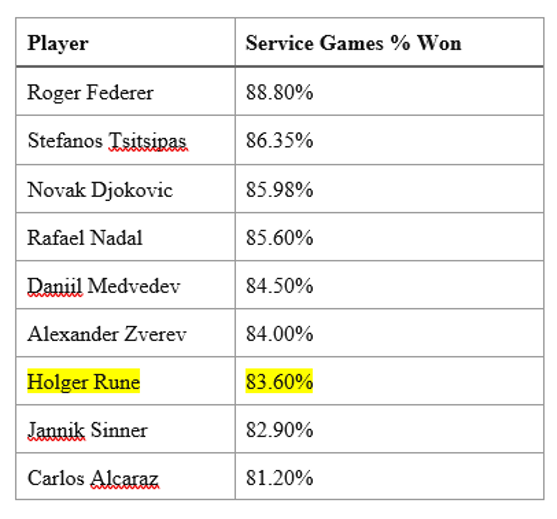
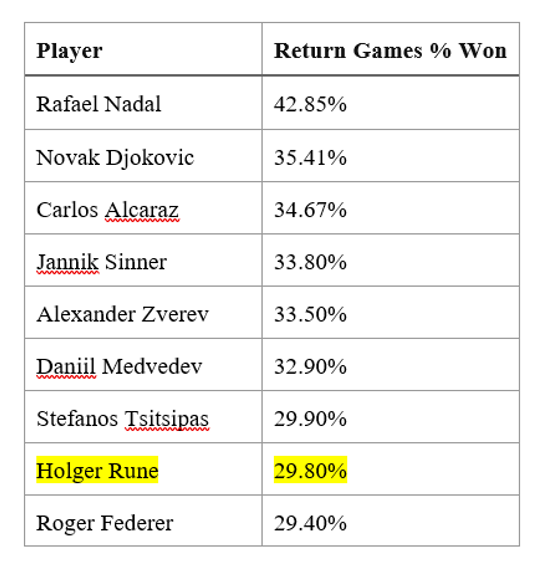
In Table 1 and in Table 2 we can see the percentage of service and return games won on clay by the big three (Federer, Nadal, Djokovic), by three top players of the following generation (Tsitsipas, Medvedev, Zverev) and by three of the emerging one (Alcaraz, Sinner, Rune).
After having acknowledged, once more, the unattainable greatness of Nadal on clay (42.85% return games won, nearly 7% more than Djokovic, one of the best returners of all time), we notice that Rune is already leading his generation for what concerns service games.
Conversely, he is behind both Sinner and Alcaraz in return games.
Rune’s serve is one of his biggest weapons on clay, as he can generate a lot of power, spin and accuracy with his motion. He has a smooth and fluid technique, with a high ball toss and a strong leg drive.
He can hit different types of serves depending on the situation, such as flat, slice or kick serves.
This shot is especially effective for him on clay because he can use the surface to his advantage. He can create high bounces with his kick serve, which makes it harder for his opponents to return.
He can vary his placement and speed to keep his opponents guessing. But is this shot equally effective also on other surfaces? Let’s have a look at what happens on hard.
Rune on Hard
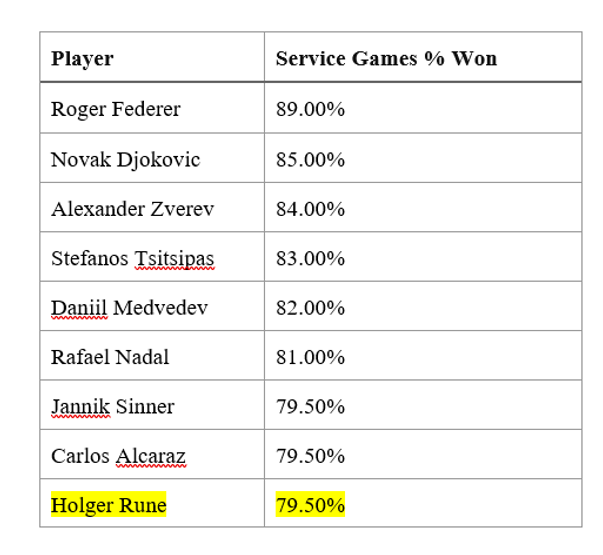
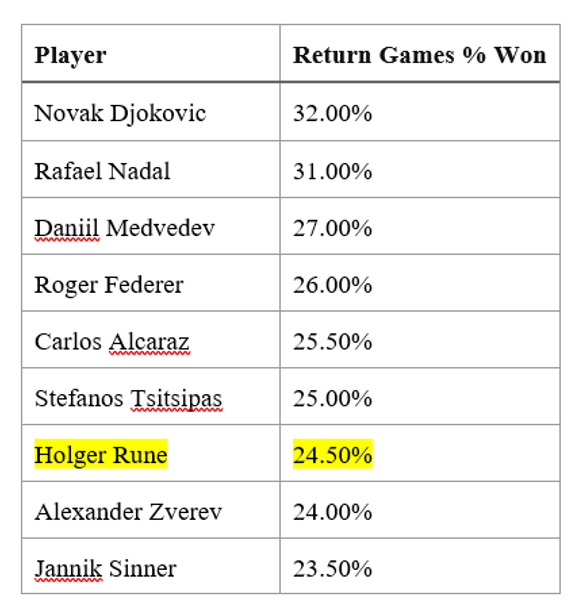
In Table 3 and in Table 4 we can see the percentage of service and return games won on hard by the same set of players that we analyzed on clay. Rune has the very same effectiveness as Alcaraz and Sinner on serve, slightly below 80%.
For what concerns return games, Rune has a better percentage of won games with respect to Sinner, and a worse one with respect to Alcaraz.
If we move also to broader and not only data-driven considerations, it is spontaneous to observe that not only the serve, but the best weapons of Holger Rune to get in control of the match (mental toughness, small number of unforced errors, heavy topspin) can work also on hard, nearly as well as on clay, as his career, up to this point, shows.
Conversely, if we compare Rune (but also Alcaraz or Sinner) to the best players of previous generations, we notice that the gap to be matched is a little bigger on hard than on clay.
Indeed, Rune, Alcaraz and Sinner tend to progress in the rally before going for the winner, while players like Federer, Zverev or Tsitsipas, especially if their first serve is in, can get more easy points, putting more pressure on the opponent, and possibly leading him to make more mistakes.
Rune on Grass
For what concerns grass, we may also say that Rune has not really started his career yet. He has only played three matches: one in Halle, one Eastbourne and one in Wimbledon, all in 2022. He lost them all, against Carreno Busta, Peniston and Giron.
Let us not focus too much on numbers here, due to scarcity of data: still, if we think about the current game style of the Danish champion, we may identify multiple reasons why is not very effective on grass.
One of them is that he likes to play with heavy topspin, high margins and long rallies, which are not very effective on grass, where the ball bounces lower and faster.
Also, Rune’s serve, which is such a good resource on hard, and even more on clay, is not as powerful or consistent as some of his rivals, if we purely focus on speed and power.
He has a career average of 6.4 aces per match on grass, which is (quite incredibly, given the relative speed of the surfaces) lower than his average on clay (7.2) and hard (8.1).
It must be said that also Sinner and Alcaraz have some more problems on grass than with any other surface.
This, of course, may have to do with the fact that contemporary players tend to focus more and more on topsin baseline shots, especially at the beginning of their career, considering that baseline shots occur much more frequently than volleys and allow to score points taking relatively smaller risks.
If Alcaraz may just need to fine-tune some shots that he already has, probably, Rune (and Sinner) will need to extend the variety of their solutions, to adapt their style and for trying to increase their winning chances, also on grass.
It looks like Sinner is already trying to be more aggressive this year, taking the net more often. Maybe we will see something like that also from Rune in the near future, and it will be a pleasure to witness it, making upcoming big matches even more engaging.